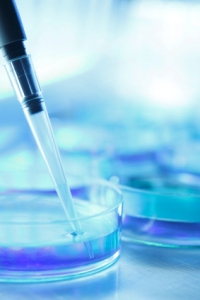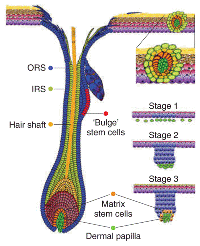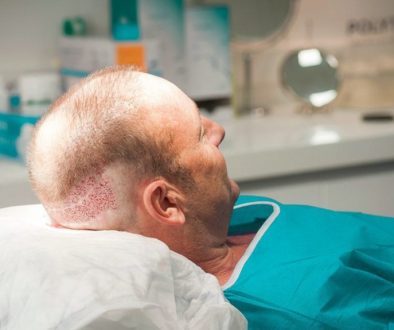Hair Loss Cure? What Physicians are Saying About the Hair Stem Cell Transplant (The Gho Procedure)
 Despite advances in robot-assisted hair transplant surgery, injectable hair loss solutions, and medication improvements, one future hair loss treatment continually met with a high level of hope and enthusiasm is the “Hair Stem Cell Transplant”, also referred to as the “Gho Procedure” or “hair regeneration via partial follicular unit extraction (P-FUE).”
Despite advances in robot-assisted hair transplant surgery, injectable hair loss solutions, and medication improvements, one future hair loss treatment continually met with a high level of hope and enthusiasm is the “Hair Stem Cell Transplant”, also referred to as the “Gho Procedure” or “hair regeneration via partial follicular unit extraction (P-FUE).”
The increased popularity and interest in the Hair Stem Cell Transplant arises from one groundbreaking ideal: the ability to extract a follicular unit, implant the graft, and re-grow a new terminal hair in its place. In theory, the Gho procedure creates an “unlimited” donor supply, allowing hair loss sufferers to undergo a series of hair restoration procedures without reducing the number of grafts available for future surgeries.
However, according to Coalition hair transplant surgeon Dr. Bill Reed, the quest to find an unlimited donor supply or theoretical cure to hair loss is not a new idea:
The quest of something for nothing is older than DeSoto’s quest for the fountain of youth or the alchemists’ desire to turn common metal into gold. In hair transplantation surgery, that quest would be finding a technique or a drug or other sources for hair that would free us from the limitations imposed by the limited amount of hair in the traditional “donor” area located on the back of our scalps.
It’s clear that the goals behind the technique are bold, but several important questions still remain: how does this new procedure work, and, most importantly, does it work?
The Gho procedure relies upon one important, and newly discovered, concept: multiple areas of stem cell activity within a hair follicle. According to the research, hair follicles contain stem cells in at least two different regions. One set of stem cells is located near the root of the hair follicle, likely in the dermal sheath, and the other is somewhere in the “bulge region” of the outer sheath (the more lateral aspect of the hair shaft itself).
During normal follicular unit extraction (FUE), a complete follicular unit graft, containing both sets of stem cells (the dermal sheath and bulge cells) is extracted and implanted in the balding scalp. Because the implanted graft contains the regenerative stem cells, it grows and cycles in the scalp like any other native follicle. However, since the follicular unit graft, containing all stem cell activity, is completely excised from the donor region, the area that was occupied by the graft now contains no regenerative follicular tissue and cannot generate a new hair (thus reducing the amount of acceptable donor hair available for future procedures).
 However, during the Gho procedure, only a partial follicular unit graft (P-FUE), containing the superficial bulge stem cells but not the deep dermal sheath cells, is removed and implanted. Because the implanted graft contains the bulge stem cells (one set of stem cells) and the non-extracted portion in the donor region contains the dermal sheath stem cells (the other set of stem cells), both areas are capable of growing and regenerating terminal hairs.
However, during the Gho procedure, only a partial follicular unit graft (P-FUE), containing the superficial bulge stem cells but not the deep dermal sheath cells, is removed and implanted. Because the implanted graft contains the bulge stem cells (one set of stem cells) and the non-extracted portion in the donor region contains the dermal sheath stem cells (the other set of stem cells), both areas are capable of growing and regenerating terminal hairs.
Although several different forms of hair regeneration procedures are currently undergoing clinical testing, the Hair Stem Cell Transplant (Gho procedure) “stands out” because it is already in daily practice at the Hair Science Institute.
The Hair Science Institute’s Hair Stem Cell Transplant relies upon the partial follicular unit extraction technique created by the clinic’s founder, Dr. Coen Gho. In an article published in the Journal of Dermatological Treatment, Dr. Gho describes the technique as a modified follicular unit extraction (FUE) procedure where the partial units are removed, inspected, treated with a “fertilizer solution” (either to keep the grafts viable or to add a matrix to help induce follicle growth), and implanted into the balding recipient area of the scalp.
According to Dr. Gho’s study, during a trial extraction of 100-150 grafts, between 69% and 94% of the partial follicular units were viable and transplanted into incisions made by the surgeon in the recipient region. Furthermore, Dr. Gho reports a 97% hair regrowth rate in the donor region and a 96% new growth rate in the recipient region, proving that true hair regeneration may in fact be possible.
Through these results, Dr. Gho reinforces the idea that hair follicles contain two different types of stem cells, located in two distinct regions of the follicular unit. Regrowth in the donor area demonstrates the presence of a set of progenitor cells in the deeper region of the follicle, likely at the dermal sheath. New growth of the partial follicular unit grafts in the recipient region demonstrates a different stem cell source, likely the bulge stem cells in the outer sheath.
Essentially, the above findings help verify the “multiple sources of follicular stem cells” theory and the ability to utilize partial follicular unit extraction for high yield hair restoration. Knowing this, hair loss sufferers may wonder why this technique isn’t utilized universally or recommended by our hair restoration community.
Although the preliminary information looks promising, it’s important to note that the Journal of Dermatological Treatment article is an isolated study and utilizes a small number of partial follicular unit grafts within a limited patient population. Additionally, although yield rates (with respect to both donor and recipient region growth) are quoted around 96.5%, objective “before and after” images of Gho Procedure patients do not appear to match these quoted values or reach the aesthetic transformations seen in traditional hair transplant surgery (follicular unit transplantation and follicular unit extraction).
Furthermore, much of the information regarding follicular stem cells and types of accelerating growth medium needed to nurture the cells is unknown and requires additional research. Until the variables associated with the cellular-based mechanisms are understood and the procedure meets the “gold standard” set by modern hair transplant surgery, patients should likely approach stem cell hair transplantation with cautious optimism.
While one opinion is helpful, it may leave other readers wondering what hair loss experts and cutting edge hair transplant surgeons think about the hair stem cell transplant procedure.
According to Coalition hair transplant surgeon Dr Raymond Konior:
Dr. Gho’s recent manuscript is well written and the concept of partial longitudinal follicular unit extraction certainly deserves consideration and ongoing study. Attempts to split follicles in the past, however, have shown how difficult it is to get something free with respect to actual hair shaft volume production above and beyond what is yielded from a single follicle.
My endorsement of a new treatment option like this is based on the relative weight of the advantages and disadvantages that the treatment offers. There certainly appears to be few, if any, disadvantages in terms of risks. The true advantages of this method will require more thorough assessment using a larger patient population and subjecting the outcomes to a statistical analysis. Dr. Gho acknowledges that the study (in the Journal of Dermatological Treatment) is limited by a small study group. I agree with that and believe more data will be necessary in order to accept or reject this interesting report.
Furthermore, Coalition surgeon Dr. Bill Reed said the following:
Dr. Gho’s quest is to be commended and is an idea worth considering thoroughly. Even if his technique grows miniaturized, smaller hairs in both the recipient and donor areas instead of full diameter hairs, it would still be a very big deal if the hair masses of the two hairs when added together were more hair mass than the hair in the donor that produced the graft (and also re-grew in its spot in the donor). I hope that Dr. Gho is correct in his hypothesis and that his supporting studies are, in fact, true. However, in my own experience and in my best scientific opinion, I think the matter is, at best inconclusive and, at worst, just wrong.
My opinion is based upon a few studies on hair growth. One study from many years ago showed that the diameter of the hair growing from a follicle is directly proportional to the number of descendents of the dermal stem cells that are apparently in the bulb and along the sheath of the lower portion of the follicle when it is in its growing phase.
The other study is one that I did about ten years ago and has been validated by other studies in which I transected the follicular unit graft into the 2/3 upper and the 1/3 lower portions of the follicle and both were planted. The growth rates were 70% growth of the lower 1/3 and 40% of the upper 2/3s. “Great!” one might say, “That’s 110% growth rate.” The problem is that all of the hair of both types were finer hairs with smaller diameters (compatible with the study mentioned above) so that the total hair mass was actually less than 100% of the hair that we started with. I am not in a position to say that this is what is happening with Dr. Gho’s patients and studies, but the existing science, other than his studies, would suggest that this is the case.
How could I be drawing the wrong conclusion? Well, life in general is a much more dynamic and non-linear process than Science would like for it to be to draw “common sense”, logical conclusions. One explanation that could make Dr. Gho’s studies prevail over other studies would be that the body “recruits” and imports stem cells from elsewhere in the body to restore the hair diameter of the portion of hair that is left behind in the donor area. That would not, however, explain how a full diameter hair would grow from a fragment of a hair follicle in the recipient area since that was not the case with the other studies mentioned above.
As I say, I hope that Dr. Gho is correct in his claims. His ideas have not been supported by other investigators, however. It is conceivable that he is still correct; this wouldn’t be the first time that something revolutionary has been unrecognized for several years, but his claims run counter to some very fundamental basic science that is supported by reasonably good studies. I look forward to reading his study in greater depth and hope that he goes into detail regarding the issues that might make a difference such as the “fertilizer” that is used. I don’t agree, for instance, that the two regions of stem cells can be taken advantage of to create two, full diameter terminal hairs. His sharing his findings could help independent investigators support his findings and, if supported, they would be truly revolutionary.
Altogether, we believe these findings are exciting and we will continue keeping readers updated with new information about the evolving field of hair regeneration via the Hair Stem Cell Transplant and other new methods.
_________________
Blake – aka Future_HT_Doc
Editorial Assistant and Forum Co-Moderator for the Hair Transplant Network, the Hair Loss Learning Center, the Hair Loss Q&A Blog, and the Hair Restoration Forum
Follow our community on Twitter
Watch hair transplant videos on YouTube
Technorati Tags: robot-assisted hair transplant surgery, hair loss, hair loss treatment, Hair Stem Cell Transplant, Gho Procedure, hair regeneration, follicular unit extraction, P-FUE, “unlimited” donor supply, hair restoration, hair transplant, hair transplantation surgery, follicular unit extraction, FUE, stem cells, Hair Science Institute, Dr. Coen Gho, follicular stem cells, hair loss



